12 start with V start with V

undertones. In this her fourth collection she finds Ovid in Provincetown,
a right whale in Iowa, and Cleopatra in the afterworld. Nothing resides
in its proper place, except the place of exile. "Characteristic wit,
irony, and precision." —Publishers Weekly

Captain Clark was a twenty-seven-year-old Knoxville businessman when the first shots of the Civil War were fired in 1861. Like many southern gentlemen, Clark was opposed to secession but could not desert his family and friends. Enlisting as a first lieutenant in the Confederacy’s Third Tennessee Infantry Regiment, he spent his first night as a soldier on the bloody battlefield of Manasses. Clark’s recollections of Manasses and the battles and skirmishes that followed pinpoint his regiment’s activities in previously undocumented areas while providing valuable analyses of battles from a participant’s point of view and discussing the irony many soldiers felt when battle pitted them against men they had known before the war in business, politics, and society.
Captured after the battle of Morristown in the fall of 1864, Clark was jailed in Knoxville, then under Federal control. His account of the eight months he spent as a prisoner—his harsh treatment, a near-fatal illness, the false accusations of traitorous activities—offer a detailed description of the physical and legal battles of a Confederate prisoner of war fighting to obtain his freedom. Clark’s post war experiences relate his struggles as a former Rebel living in a conquered state, reflecting the deeply divided loyalties of East Tennessee that continued for years after the war’s end.
This first book in the Voices of the Civil War series shares the story of a man who remained sensible of his kinship with those he was forced to call his enemies. Written a quarter-century after the war began, Clark's memories vividly bring to life the tragedy that was the Civil War.
Willene B. Clark, a granddaughter of Captain Clark, is a professor of art history at Marlboro College, Marlboro, Vermont.

A member of a middle-class family that had moved to Knoxville in 1860 from Georgia, Ellen House became, like her parents and siblings, a fervent Confederate—or, as she called herself, “a very violent Rebel.” When the city fell to Federal forces in September 1863, Ellen’s resentments ran deep, and she filled her diary with scornful words for the occupying Yankees. She eagerly followed the news of military actions that might mean the recapture of the city and became an eyewitness to the war’s dangers when Confederate General James Longstreet launched an ill-fated attack on Knoxville late in 1863. Despite her own privations, Ellen gave much of her time to providing relief to Confederate prisoners of war in the city. Since she made no secret of where her sympathies lay, Federal military authorities eventually suspected her of spying and expelled her to Georgia, where she continued to record her impressions and observations.
Only recently brought to light by the diarist’s descendants, this compelling personal record has been meticulously edited and annotated by Daniel Sutherland. The resulting volume adds a spirited and articulate voice to the chorus of available firsthand testimony on America’s bloodiest conflict.
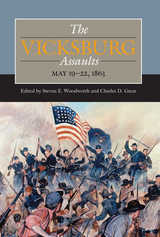
But due to difficult terrain, strong defenses, and uncoordinated movements, the quick triumph Grant desired was unattainable. On the afternoon of May 19, with little rest, preparation, or reconnaissance, Union forces charged the Confederate lines only to be repulsed. A respite between the assaults allowed both sides to reinforce their positions. Early on May 22 the Union artillery sought to soften the stronghold’s defenses before the general attack, but despite the Union forces’ preparation, the fighting proved even more disorganized and vicious. Again Grant failed to move Pemberton. Not wanting to risk more soldiers in a third attack, Grant conceded to the necessity of laying siege. Confederate morale climbed as the Southerners realized they had held their ground against an overwhelming force.
Editors Steven E. Woodworth and Charles D. Grear have assembled five captivating essays that examine Grant’s unsuccessful assaults against Confederate defensive lines around Vicksburg. Ranging from military to social history, the essays further historical debates on prominent topics, such as the reactions of Midwesterners to the first failures of Grant’s Vicksburg campaign. Two essays from opposing sides analyze the controversial decisions surrounding the Railroad Redoubt, the site of the bloodiest fighting on May 22. Another investigates how the tenacity of Texan reinforcements forced Union soldiers to abandon their gains.
Peppered with first-hand observations and bolstered by an impressive depth of research, this anthology is an invitingly written account and comprehensive assessment. By zeroing in on the two assaults, the contributors offer essential clarity and understanding of these important events within the larger scope of the Civil War’s Vicksburg Campaign.
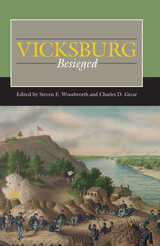
Vicksburg, Mississippi, held strong through a bitter, hard-fought, months-long Civil War campaign, but General Ulysses S. Grant’s forty-day siege ended the stalemate and, on July 4, 1863, destroyed Confederate control of the Mississippi River. In the first anthology to examine the Vicksburg Campaign’s final phase, nine prominent historians and emerging scholars provide in-depth analysis of previously unexamined aspects of the historic siege.
Ranging in scope from military to social history, the contributors’ invitingly written essays examine the role of Grant’s staff, the critical contributions of African American troops to the Union Army of the Tennessee, both sides’ use of sharpshooters and soldiers’ opinions about them, unusual nighttime activities between the Union siege lines and Confederate defensive positions, the use of West Point siege theory and the ingenuity of Midwestern soldiers in mining tunnels under the city’s defenses, the horrific experiences of civilians trapped in Vicksburg, the Louisiana soldier's defense of Jackson amid the strains of piano music, and the effect of the campaign on Confederate soldiers from the Trans-Mississippi region.
The contributors explore how the Confederate Army of Mississippi and residents of Vicksburg faced food and supply shortages as well as constant danger from Union cannons and sharpshooters. Rebel troops under the leadership of General John C. Pemberton sought to stave off the Union soldiers, and though their morale plummeted, the besieged soldiers held their ground until starvation set in. Their surrender meant that Grant’s forces succeeded in splitting in half the Confederate States of America.
Editors Steven E. Woodworth and Charles D. Grear, along with their contributors—Andrew S. Bledsoe, John J. Gaines, Martin J. Hershock, Richard H. Holloway, Justin S. Solonick, Scott L. Stabler, and Jonathan M. Steplyk—give a rare glimpse into the often overlooked operations at the end of the most important campaign of the Civil War.
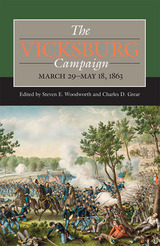
Ulysses S. Grant’s ingenious campaign to capture the last Confederate stronghold on the Mississippi River was one of the most decisive events of the Civil War and one of the most storied military expeditions in American history. The ultimate victory at Vicksburg effectively cut the Confederacy in two, gave control of the river to Union forces, and delivered a devastating blow from which the South never fully recovered. Editors Steven E. Woodworth and Charles D. Grear have assembled essays by prominent and emerging scholars, who contribute astute analysis of this famous campaign’s most crucial elements and colorful personalities.
Encompassed in this first of five planned volumes on the Vicksburg campaign are examinations of the pivotal events that comprised the campaign’s maneuver stage, from March to May of 1863. The collection sheds new light on Grant’s formidable intelligence network of former slaves, Mississippi loyalists, and Union spies; his now legendary operations to deceive and confuse his Confederate counterparts; and his maneuvers from the perspective of classic warfare. Also presented are insightful accounts of Grant’s contentious relationship with John A. McClernand during the campaign; interactions between hostile Confederate civilians and Union army troops; and the planning behind such battles as Grierson’s Raid, Port Gibson, Raymond, Jackson, Champion Hill, and Big Black River Bridge.

". . . the definitive history of the Shelton Laurel Massacre, but more important it is a pathbreaking study of a principal theater of the guerrilla aspect of the Civil War. Paludan has succeeded admirably in rooting a historically neglected topic in the lives of ordinary people."—Frank L. Byrne, American Historical Review
"The questions Paludan asks about Shelton Laurel in 1863 are appropriate to My Lai in 1968 and Auschwitz in 1944. Victims is not only a good book; it is also an important book. And it is a profoundly disturbing book."—Emory M. Thomas, Georgia Historical Quarterly
"Outwardly a superb analysis of the impact of war and war-time atrocity on the life of a remote mountain community, this slim volume harbors far-reaching implications for the study of class conflict and the modernization process in the Appalachian region."—Ron Eller, Appalachian Journal
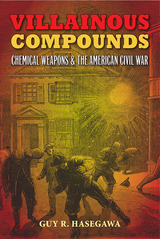
In chilling detail, Hasegawa describes the weapons proposed and prepared for use during the war and introduces the people behind the concepts. Although many of the ideas for chemical weapons had a historical precedent, most of the suggested agents were used in industry or medicine, and their toxicity was common knowledge. Proponents, including a surprisingly high number of civilian physicians, suggested a wide variety of potential chemical weapons—from liquid chlorine in artillery shells to cayenne pepper solution sprayed from fire engines. Some weapons advocates expressed ethical qualms, while others were silent on the matter or justified their suggestions as necessary under current circumstances.
As Hasegawa explains, bureaucrats in the war departments of both armies either delayed or rejected outright most of these unusual weapons, viewing them as unneeded or unworkable. Nevertheless, many of the proposed armaments presaged the widespread use of chemical weapons in the twentieth and twenty-first centuries. For example, while Civil War munitions technology was not advanced enough to deliver poison gas in artillery shells as some advocates suggested, the same idea saw extensive use during World War I. Similarly, forms of an ancient incendiary weapon, Greek fire, were used sparingly during the Civil War and appeared in later conflicts as napalm bombs and flamethrowers.
Especially timely with today’s increased chemical threats from terrorists and the alleged use of chemical agents in the Syrian Civil War, Villainous Compounds: Chemical Weapons and the American Civil War reveals the seldom-explored chemical side of Civil War armaments and illuminates an underappreciated stage in the origins of modern chemical warfare.
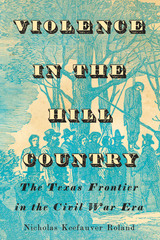
2022 Ramirez Family Award for Most Significant Scholarly Book, Texas Institute of Letters
An in-depth history of the Civil War in the Texas Hill Country that examines patterns of violence on the Texas frontier to illuminate white Americans’ cultural and political priorities in the nineteenth century.
In the nineteenth century, Texas’s advancing western frontier was the site of one of America’s longest conflicts between white settlers and native peoples. The Texas Hill Country functioned as a kind of borderland within the larger borderland of Texas itself, a vast and fluid area where, during the Civil War, the slaveholding South and the nominally free-labor West collided. As in many borderlands, Nicholas Roland argues, the Hill Country was marked by violence, as one set of peoples, states, and systems eventually displaced others.
In this painstakingly researched book, Roland analyzes patterns of violence in the Texas Hill Country to examine the cultural and political priorities of white settlers and their interaction with the century-defining process of national integration and state-building in the Civil War era. He traces the role of violence in the region from the eve of the Civil War, through secession and the Indian wars, and into Reconstruction. Revealing a bitter history of warfare, criminality, divided communities, political violence, vengeance killings, and economic struggle, Roland positions the Texas Hill Country as emblematic of the Southwest of its time.

important African-American war correspondent of his era, served in the
famed black Fifty-fourth Massachusetts Regiment, subject of the film Glory.
His letters from the front, published in the New York Weekly Anglo-African,
brilliantly detail two wars: one against the Confederacy and one against
the brutal, debilitating racism within his own Union Army. Together with
Donald Yacovone's biographical introduction detailing Stephens's life
and times, they provide a singular perspective on the greatest crisis
in the history of the United States.
Stephens chronicled the African-American
quest for freedom in reports from southern Maryland and eastern Virginia
in 1861 and 1862 that detailed, among other issues of the day, the Army
of the Potomac's initial encounter with slavery, the heroism of fugitive
slaves, and the brutality both Southerners and Union troops inflicted
on them.
From the inception of the
Fifty-fourth early in 1863 Stephens was the unit's voice, telling of its
struggle against slavery and its quest to win the pay it had been promised.
His description of the July 18, 1863, assault on Battery Wagner near Charleston,
South Carolina, and his writings on the unit's eighteen-month campaign
to be paid as much as white troops are gripping accounts of continued
heroism in the face of persistent insult.
The Weekly Anglo-African
was the preeminent African-American newspaper of its time. Stephens's
correspondence, intimate and authoritative, takes in an expansive array
of issues and anticipates nearly all modern assessments of the black role
in the Civil War. His commentary on the Lincoln administration's wartime
policy and his conviction that the issues of race and slavery were central
to nineteenth-century American life mark him as a major American social
critic.
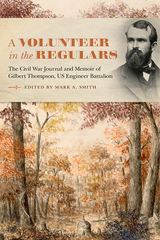
At the outbreak of the Civil War, Massachusetts native Gilbert Thompson joined the regular army, which assigned him to the engineer battalion, a unit that provided critical support for the Union military effort in building bridges and roads and surveying and producing maps. While serving, Thompson kept a journal that eventually filled three volumes. The author’s early education in a utopian community called Hopedale left him well read, affording a journal peppered with literary allusions. Once the war ended, Corporal Thompson added some postwar reflections to create a unified single volume, which editor Mark A. Smith has carefully arranged so that the reader can clearly distinguish between Thompson’s contemporary accounts and his postwar reminiscences. An accomplished artist and topographer, Thompson illustrated his journals, adding depth to his narrative with portraits of key figures, drawings of ordinary scenes such as soldiers playing chess, and sights of the war. Additionally, he collected photographs both during and after the war, many of which are included.
Thompson’s wartime musings and postwar recollections have much to offer. Few diaries contain glimpses into the workings of a highly specialized unit such as the engineer battalion, and Thompson’s skills in depicting daily camp life in both words and pictures provide a distinctive look at the Union Army during the Civil War as well as an insightful look into the human condition. In his 1879 introduction, Thompson writes, “I wonder how I wrote as much and as well, and am thankful I was so fortunate as to have the opportunity to do so.” Students of the Civil War will feel fortunate he did.
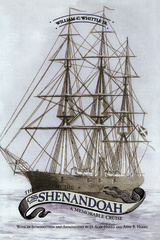
The only Confederate ship to circumnavigate the globe
The Confederate cruiser Shenandoah was the last of a group of commerce raiders deployed to prey on Union merchant ships. Ordered to the Pacific Ocean to “greatly damage and disperse” the Yankee whaling fleet in those waters, the Shenandoah’s successful pursuit of her quarry compared favorably with the exploits of the more celebrated Alabama and Florida but has never been as well known because it coincided with the war’s end and the Confederacy’s downfall. It was, however, one of the best documented naval expeditions—from England to the Indian Ocean, Australia and the South Pacific, the Bering Sea, San Francisco, and finally to port in Liverpool—during the Civil War.
The ship’s log and Captain James Waddell’s notes are well preserved, and a number of the Shenandoah’s officers kept detailed journals of the entire voyage. One of the most significant journals, by Lieutenant William Whittle, is presented here, with annotations from other journals, the official records and logs, and newspaper accounts of the Shenandoah’s activities, together bringing to life the history of this remarkable voyage.
READERS
Browse our collection.
PUBLISHERS
See BiblioVault's publisher services.
STUDENT SERVICES
Files for college accessibility offices.
UChicago Accessibility Resources
home | accessibility | search | about | contact us
BiblioVault ® 2001 - 2024
The University of Chicago Press









